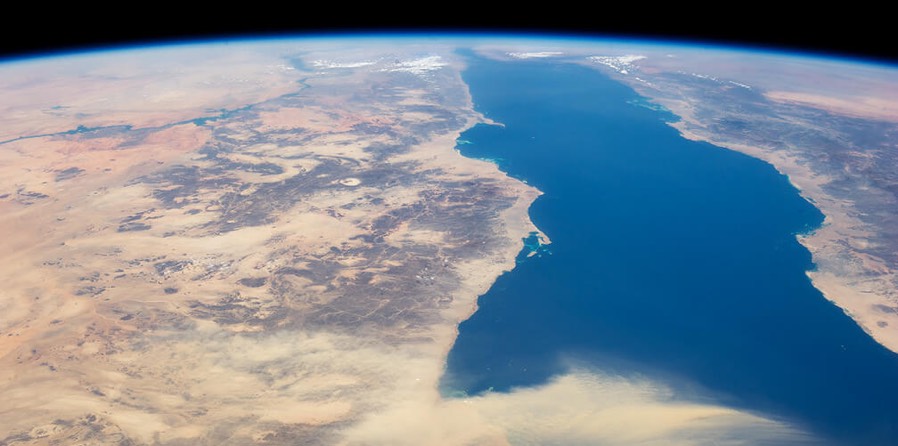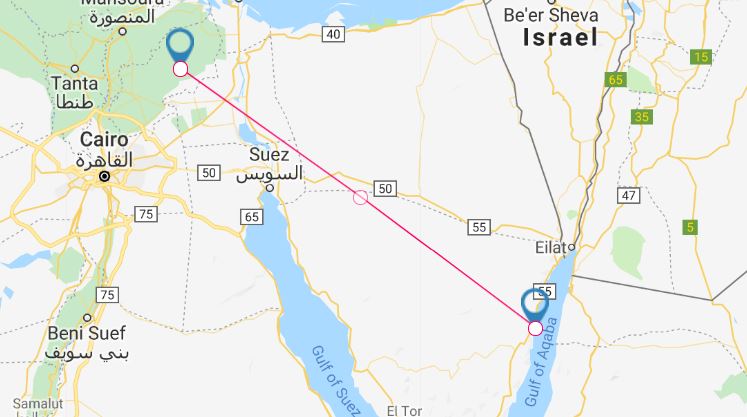Could the Israelites Reach the Red Sea and Mount Sinai in The Bible's Timeframe?

The journey to Mount Sinai involved a number of stages. Since Moses and the Israelites had to travel a few hundred kilometers, asking about their travel time frame is a legitimate question. Our research leads us to conclude that a journey from Goshen to the Red Sea, and on to Mount Sinai in Midian, fits the Biblical timeframe.
According to the books of Exodus and Numbers, the stages of the journey to Mount Sinai from Goshen were as follows:
- Leaving Egypt on Passover, the 14th day of the first month, Nisan (Exodus 12:42-51)
- From Rameses (in the land of Goshen, the Nile delta) to Succoth
- From Succoth to Etham (Exodus 13:20)
- From Etham to Pi-hahiroth, at Migdol
- From Pi-hahiroth through the Red Sea, through the wilderness for three days to Marah
- From Marah to Elim
- From Elim to the camp by the Red Sea
- From the Red Sea camp to the Wilderness of Sin on the 15th day of Iyar (Exodus 16:1)
- From the wilderness of Sin to Dophkah
- From Dophkah to Alush
- From Alush to Rephidim
- From Rephidim to Sinai, arriving on the 1st day of the third month, Sivan (Exodus 3:1)
The journey to Mount Sinai lasted from the middle of the first month to the first day of the third month. The Hebrews left Egypt shortly after their Passover meal, when Pharaoh summoned Moses and finally released them to worship God in the wilderness.
When the Hebrews began their Exodus, it would only have been natural for them to travel to the Promised Land by the "way of the land of the Philistines," which ran close to the shores of the Mediterranean. However, God instructed them to take another route. The text seems to indicate that the original path was an established, known route out of Egypt.
“The people might change their minds when they see war, and return to Egypt.” - Exodus 13:17
Moses then led the Hebrews off of the established path, onto another one that led into the mountainous "wilderness" to get to the Red Sea. Egypt's Sinai Peninsula is full of rugged, mountainous terrain that would fit this description.
As the Jewish historian Josephus recounted in Book II, chapter 15 of The Antiquities of the Jews:
And indeed that land was difficult to be traveled over, not only by armies, but by single persons. Now Moses led the Hebrews this way, that in case the Egyptians should repent and be desirous to pursue after them, they might undergo the punishment of their wickedness, and of the breach of those promises they had made to them. As also he led them this way on account of the Philistines, who had quarreled with them, and hated them of old, that by all means they might not know of their departure, for their country is near to that of Egypt; and thence it was that Moses led them not along the road that tended to the land of the Philistines, but he was desirous that they should go through the desert, that so after a long journey, and after many afflictions, they might enter upon the land of Canaan.
Turning aside from the way of the Philistines indicates that the Hebrews traveled in a southerly or southwesterly direction. By traveling in this direction, this would lead the Hebrews towards the southern part of the Sinai peninsula, or the middle part of the Peninsula facing the Gulf of Aqaba.
From Rameses to Nuweiba Beach, which we believe is the strongest candidate for the Red Sea Crossing, the straight-line distance is 337 kilometers or 209 miles.

In a straight line from Rameses's approximate location to Jabal Maqla in Saudi Arabia, our favored candidate for Mount Sinai, the distance is 411 kilometers or 255 miles.

Obviously, Moses and the Hebrews did not travel in a straight line, so the actual distance traveled must be longer. They first traveled eastwards across the northern part of today's Sinai Peninsula "on the way of the Philistines." They then backtracked from Etham to go off-route into the "wilderness," ultimately encamping before Migdol by the Red Sea (Exodus 14).
Josephus further stated that the Hebrews left Egypt in haste and came to the shores of the Red Sea in three days.
[A]s they went away hastily, on the third day they came to a place called Beelzephon, on the Red Sea...
One common criticism of the theory that the Gulf of Aqaba was crossed and that Mount Sinai must be in Saudi Arabia focuses on the time it would have taken to travel this distance. The criticism assumes that the Hebrews only had three days of travel and that Nuweiba Beach would therefore be an impossibility. However, a closer look at the Biblical text offers a potential explanation.
Exodus 13:21-22 states that the Hebrews did not merely travel during the day, but also at night. This means they traveled twice as far as a daytime-only traveler would have.
The Lord was going before them in a pillar of cloud by day to lead them on the way, and in a pillar of fire by night to give them light, that they might travel by day and by night. He did not take away the pillar of cloud by day, nor the pillar of fire by night, from before the people.
In addition, the Bible makes it clear that they were fleeing and moving as quickly as they could.
As Exodus 19:4 states, You yourselves have seen what I did to Egypt, and how I carried you on eagles' wings and brought you to myself.
This particular passage indicates that there may have been divine assistance in their travels as well. If God helped the Israelites move more quickly, and/or gave them extra endurance for this journey, that could explain how such a lengthy journey could be accomplished so quickly.
Rabbi Alexander Hool, author of Searching for Sinai: The Location of Revelation, notes that Tractate Pesachim 93b records the average pace for traveling in ancient times was about forty Hebraic Miles in a day (with one Hebraic mile equaling 0.95 kilometers). Tractate Pesachim's record of the Exodus has them traveling 120 Hebraic miles per day.
120 Hebraic miles equals 114 kilometers. For three days, that equals about 340 kilometers traveled. If this was the pace, the Hebrews could have reached Nuweiba Beach in that time-frame. (Note: Rabbi Hool places the starting point, Ramesses, further north, close to the shore of the Mediterranean Sea).
So could the Hebrews have reached the shores of the Gulf of Aqaba in three days' and nights' time? Could they have reached Mount Sinai in the Bible's time-frame? We contend that the answer is yes.
If it was three days and nights from Egypt to the Red Sea, this means the Hebrews' time traveled was approximately 72 hours to get to the sea, rather than approximately 36 hours if they only traveled during daylight. The correct Red Sea Crossing point should be on the outer limit of 72 hours of travel and not significantly less than that distance. Egypt's Nuweiba Beach fits these criteria.
The Hebrews took another 42 days to go from the encampment at the Red Sea to Mount Sinai, obviously moving at a much slower pace as they were no longer fleeing the Egyptian army that was in hot pursuit. Our favored candidate of Jabal Maqla in Saudi Arabia fits these parameters.
There is another proposed crossing site at the southern end of Egypt's Sinai Peninsula at the Straits of Tiran. Bob Cornuke of the BASE Institute believes that this is where Moses and the Israelites crossed the Red Sea. The Doubting Thomas Research Foundation currently believes that Nuweiba Beach is a more fitting location, though we do not discount the possibility of the Straits of Tiran theory.
On our Red Sea Crossing page, we detail reasons why Nuweiba fits better than Tiran. As stated above, from Rameses to Nuweiba, the trip is over 200 miles. From Rameses to Tiran, the distance is further, though, at nearly 250 miles if you assume a direct trip (which it wasn't). The actual journey may have been closer to 300 miles or more with its twists and turns.
The Nuweiba crossing point is already a long distance from Rameses. The distance to the Straits of Tiran, is, in our assessment, is significantly more difficult to accomplish in three days and nights.
There are several other time-frame theories as well. Josephus is a well-trusted historian, though he certainly is not infallible. There are other alleged time-frames for the journey from Egypt to the Red Sea, each of which could fit into the Biblical account.
The Jewish Midrash tradition identifies the time between Egypt and the Red Sea as seven days. Dr. Glen Fritz notes in his book The Lost Sea of the Exodus that the idea was tied to the Feast of the Unleavened Bread, which ended seven days after the Passover. The thought was that the unleavened bread ran out on the seventh day, and that this coincided with the Red Sea crossing. Dr. Fritz notes, however, that there is not any specific indication of this in the Biblical text, as the manna provided by God did not fall until a month after departing from Egypt (62).
If the journey to the Red Sea took seven days instead of three, then either Nuweiba or Tiran could be a crossing point. Seven days would be a more achievable timeframe to reach the shores of the Red Sea, even without divine assistance as the Biblical text seems to indicate.
The description of the Red Sea crossing itself indicates that Nuweiba Beach is the best candidate for the crossing site, as we detail on our page dedicated to this subject.
Last updated July 31, 2019

I’ve read a few excellent stuff here. Definitely price bookmarking for revisiting.
I surprise how much attempt you place to create this sort of
great informative website.
Very imformative website! I go to this site every day!
They had Passover in Egypt before they left, Pentecost is 50 days and 40 of them days, Moses was up on the mountain and gave them the commandments on Pentecost. Of coarse the tribes didn’t get them for 80 days because of their sin, they missed Pentecost. A man can run 5 miles in less than an hour. They weren’t lazy Americans, they were buff and strong slaves who worked hard and very fit. So they made it from Egypt to Mt Sinai/Jabal Al Lawz in 10 days. And I’m sure YaH helped. And actually He could have just lifted them up and zapped them where He wanted them at anytime like He had done with others. Anyways, I’m believing now that it had to have been 10 days or less. Thank you so much for the maps. Shalom.
Oh and a man can jog 5 miles in less than an hour but even if it took 1/2 an hour per mile which me and my husband can do easily and we are old and not fit. If it’s 300 miles and 1/2 hr per mile, that’s 150 hours, approximately 6.25 days of non stop and if they rested they could have made it in 8 or 9 days. With time left over to build the alters and the rock pillars. And this allows Moshe to be in the mountain 40 days to come and give the commandments on Pentecost. Plus they had supernatural help! HalleluYah!
What do you think?
Very interesting. Where exactly does it say in Tractate Pesachim that the Hebrews covered 120 Hebraic miles during the Exodus?
The Exodus mirrors the Messiah’s death, resurrection, and ascension, and one needs to consider this when talking about timeframes:
https://www.researchgate.net/publication/350386807_Timeline_of_the_Exodus
Hello Jörn! The figure of 120 Hebraic miles of travel per day from Rameses (Avaris) to the sea is actually derived from 2 Rabbinic texts/traditions. These are both highlighted in Rabbi Alexander Hool’s book, “Searching for Sinai: The Location of Revelation,” on pages 35 and 36.
First, Rabbi Hool points out that Tractate Pesachim 93b records the average rate of ancient travel to be 40 Hebraic miles per day.
Next, Rabbi Hool cites Rashi’s commentary on Exodus 12:37 which relays a Rabbinic tradition that the Israelites traveled 120 Hebraic miles in a single day from Rameses (Avaris) to where he believed Sukkot to be located. If so, this would mean that the Israelites traveled at 3 times the normal rate of ancient travel according to the rate given in Tractate Pesachim 93b.
Rabbi Hool attributes this to the miraculous circumstances surrounding the Israelites departure from Egypt.
If there is any truth to these Rabbinic traditions, one can extrapolate the first 120 Hebraic miles of travel in 1 day and apply it to the concept of 3 days of travel from Rameses (Avaris) to the sea crossing site – which we believe to be Nuweiba Beach on the Gulf of Aqaba. 120 Hebraic miles, multiplied by 3 days equates to 360 Hebraic miles of travel covered in that amount of time.
360 Hebraic miles equates to 210 modern miles. The distance between Rameses (Avaris) and Nuweiba Beach is 209 miles as the crow flies – obviously it would be a bit more in terms of on-the-ground travel though.
Nonetheless, again, if there is any stock to these Rabbinic traditions, the 3 days of travel between Avaris and the sea is possible.
Our team does not necessarily hold to this or agree with these traditions though.
We believe it’s much more likely that it took longer than 3 days to reach the sea, at the very least a week and possibly even more. Our thinking is more in alignment with that of Dr. Glen Fritz who points out that the Bible does not actually give the specific number of days it took to reach the sea.
With this in mind, there are a variety of options that would fit the overall timeframe the Bible gives for how long it took the Israelites to reach Mount Sinai, which was in the 3rd month after they had left Egypt according to Exodus 19. This is an exact timeframe the Bible does give by which we can construct a good estimate for rate of travel/time of travel between the various stops along the route.
We definitely wanted to include information about the Rabbinic traditions though – as we feel they are important to consider and – again – they do make the concept of 3 days of travel from Avaris to the sea possible if there is truth to them.
Your idea that the Exodus mirrors the death, resurrection, and ascension of the Messiah is very interesting! It would be intriguing to learn more about this!